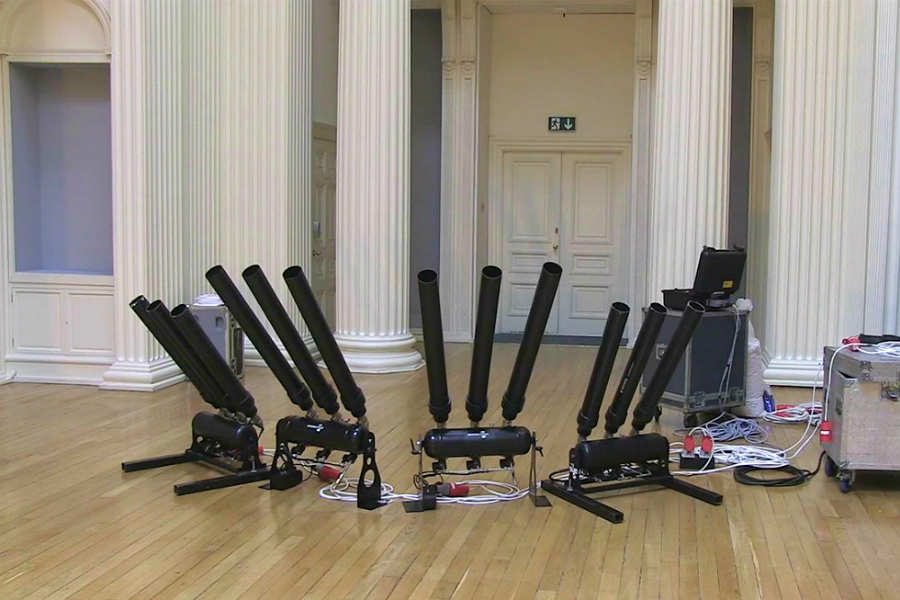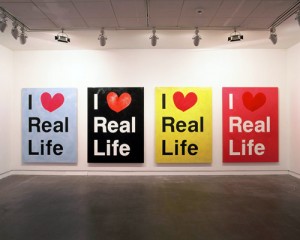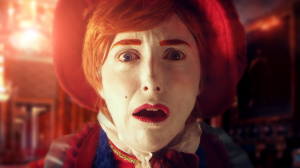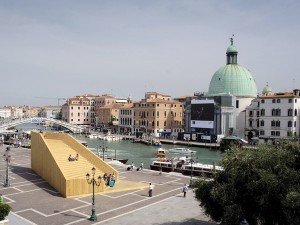“The SNP, Alex Salmond – It’s So Boring”: Artists On Scottish Independence

In 14 days, Scotland will be voting to decide whether to become an independent nation or remain part of the UK. a-n’s Chris Sharratt speaks to artists and those working in the visual arts in the country and finds thinking that runs much deeper than nationalism, oil revenues and questions of currency…
There are four confetti cannons installed at the Talbot Rice Gallery, Edinburgh, hooked up to a firing mechanism with the word ‘Yes’ written on it. The work of Ellie Harrison, the artist is hoping that there’ll be plenty of cleaning up to do in the gallery the day after Scotland’s independence referendum on 18 September – and that most of the country will have put a cross against ‘Yes’ when it votes. Only if they do will the cannons be fired.
The piece, After The Revolution, Who Will Clear Up The Mess?, may have an ambiguous title, but its maker’s voting intentions are clear. “When you’re offered the opportunity for change, I think you’d be a fool not to take it,” says Harrison, who moved from London to Scotland in 2008 to do the MFA at Glasgow School of Art. “I like the idea of a Socialist Republic of Scotland – I guess that’s what I’m voting for, to see whether or not that is possible.”
Scotland’s visual artists haven’t been especially vocal about which way they’ll be voting in this historic referendum – at least not publicly. While many others in the arts – in particular writers and those involved in theatre – have been openly debating the decision, the visual arts has been a little reticent in comparison. As if to amplify this point, a recent referendum debate in Glasgow organised by the Scottish Artists Union (SAU) featured a four-strong panel with no visual artists on it.
Janie Nicoll is both a practising visual artist and vice-chair of the SAU. While the union has understandably taken a neutral position on independence – “We felt it was important to do so because we represent over 1000 visual and applied artists in Scotland, all of which have different opinions” – Nicoll herself is firmly in the Yes camp. “A few years ago I didn’t really consider independence,” she says. “For me it’s been about a gradual politicisation and awareness of the arguments – about a year and a half ago I started to feel quite strongly pro-independence.”
Scotland’s First Minister Alex Salmond and UK Prime Minister David Cameron signed the Edinburgh Agreement on 15 October 2012, paving the way for a vote on Scottish independence. It’s something that happened a few days earlier, however, that Nicoll cites as a key moment in her journey towards a Yes vote – namely, the Scottish arts community’s revolt against Creative Scotland, expressed in a damning open letter that called for a total rethink of the Scottish arts funding body’s approach.
“I think the whole Creative Scotland stooshie really galvanized artists in Scotland,” she says. “They couldn’t really ignore what was happening.” Nicoll believes the campaign to reform Creative Scotland, the eventual resignation of its then chief executive Andrew Dixon, and the period of ‘open sessions’ and consultation with artists that followed, has played its part in making Yes the preferred choice of many Scottish artists. Not, she stresses, because of a rise in nationalist sentiment, but rather because it rekindled a belief in the power of discussion, debate and ultimately democracy to deliver change in a small country like Scotland.
“The whole nationalist thing – the SNP, Alex Salmond – it’s so boring,” she stresses. “I don’t see myself as a nationalist and it’s not about nationalism at all – it’s about Scotland being a proper, functioning democracy.”
Nicoll has been playing a direct part in that democracy through her involvement with a Scottish Parliament cross-party group on culture, an experience that has helped convince her that cutting Westminster out of the equation and gaining full independence is the only way to get a truly representative democracy in Scotland. “It’s a gamble, yes, but voting No and continuing to go cap in hand to Westminster is more of a gamble than independence,” she says.
The artist Ross Sinclair shares Nicoll’s antipathy to Westminster, including her desire for change and belief that a Yes vote is the way to achieve this. As someone who for the last 25 years has explored ideas around Scottish national identity and culture, he’s hardly new to the politics of independence. Yet he too has found himself galvanized by the idea in the last few years, particularly as he’s watched the increasing lurch to the right in mainstream UK politics.
“I wasn’t rabidly Yes to begin with, but over the last two years in particular that’s become more of a focus. The more I see coming out of Westminster on almost any topic just makes me more and more disinclined to imagine a future UK under, say, a Boris Johnson premiership. It horrifies me what that would mean for somewhere like Scotland.”

Sinclair studied on the Enviromental Art course at Glasgow School of Art, graduating in 1990. As part of Generation – the Scotland-wide celebration of the last 25 years of Scottish art – he has remade his 1996 piece, Real Life, Rocky Mountain, at the Scottish Gallery of Modern Art. Restaging the work, which in part involves singing Scottish folk songs while sitting on a fabricated Highland mountain landscape surround by stuffed wild animals, has brought into focus how much has changed in Scotland in the intervening years.
“It feels that the work sits so well with the current debate around the referendum and everything, but 20 years ago that clearly wasn’t the case,” says Sinclair. “When I made it the first time the idea of a Scottish parliament was by no means certain, never mind a referendum on independence. So I think nothing can be taken for granted.”
Sinclair’s vision of an independent Scotland is one that has no time for narrow ideas of nationalism. He sees the international success of many of the country’s visual artists over the last 20 years as an example of how culture and the arts has influenced politics, rather than the other way round. “In my imagination, artists have really been at the vanguard of the changes that are being made possible in Scotland. In the last 20 years, and particularly in the visual arts because that’s what I’m closest to, I’ve seen the demographic change completely in Scotland and particularly in Glasgow.
“When I first started at art school in the 1980s it was all west of Scotland people going to Glasgow School of Art. I’ve worked at the art school for the last 20 years and that has changed dramatically. Now you get kids coming from all over the world to study and a lot of them stay afterwards. They’re now making up this community of artists in Scotland and that’s positive and exciting. How the visual arts has developed is a model for how the whole country could develop.”
Clearly, whatever the outcome of the independence referendum, Scotland is a changed place compared to even ten years ago – anyone watching the Commonwealth Games in Glasgow, seeing Scottish athletes singing Flower of Scotland and, perhaps even more significantly, Scottish sports fans also cheering the success of English athletes, can surely see that. The confidence of Scotland’s artists is increasingly reflected across the rest of society – and discussion of what it means to be Scottish, British or both has been given a new and soberingly real context. It’s a reality that has certainly played its part in the work of Glasgow-based artist Rachel Maclean, who grew up in the small town of Dollar, Clackmannanshire, before going to university in Edinburgh.
“When I was at art college in Edinburgh [2005-2009] I made a lot of work that dealt with Scottish identity, but more from a touristic point of view – a Walter Scott, Braveheart, Loch Ness Monster and kilts vision of Scotland, a kind of fantasy land. It was only really in 2011 with the SNP landslide that this idea of Scottish identity became so clearly politicised. That made me think that if I was dealing with this particular idea then I needed to more specifically address it to the referendum debate.”
While Maclean’s work dives headfirst into the cultural, social and economic history of the UK from the days of empire to the present – her 2014 show at the Centre for Contemporary Arts (CCA), Glasgow was titled Happy & Glorious and offered a darkly comic excavation of national identity – she’s reticent about saying which way she’ll be voting in the referendum.
“With the work I make I think it would really change it if I said one way or another,” she explains. “The minute you say it should be read in a particular way, all the grey areas and nuances of the work and your argument get completely ironed out. So it’s really important to seem, not neutral, but to not have a strong answer one way or another.”

Great art, of course, is rarely about black and white, yes and no – it doesn’t sit easily in the world of political argument and counter argument that characterises much of the mainstream debate around Scottish independence. But whether they’re willing to say which way they’ll vote or not, what comes through strongly from talking to artists in Scotland is a sense of a very different conversation to the one being served up in TV debates and most of the media.
Crucially, it’s a conversation that sees the idea of an independent Scotland as a possibility for a different kind of society rather than an end in itself. Perhaps unsurprisingly given art’s lack of respect for political and national boundaries, it’s less about borders and flag waving and more about a space to imagine new ways of doing things. Oil reserves and keeping the pound don’t really figure much in this discussion.
Dumfries-based public artist Matt Baker, who is also part of the town’s artist-run Stove Network, is voting Yes but is well prepared for the reality of a No vote – particularly as he lives in an area that returned the Conservatives’ sole Westminster seat in the 2010 General Election, courtesy of David Gordon Mundell, MP for Dumfriesshire, Clydesdale and Tweeddale.
“I’ve always felt that this is progress whether it’s Yes or No,” he says. “And I don’t think a Yes vote is some kind of panacea. At the outset of this it was quite a top-down vision of independence, which was effectively being driven by the machinery of the SNP. What I see around me now is a lot of very energized, bright-eyed, serious people who are thinking about their situation, and I think that whatever happens we just need to think of a way to harness that.”
Those bright-eyed people are often not aligned to a particular party, although some can be found in pro-independence organisations such as the National Collective (‘artists and creatives for Scottish independence) or involved in Common Weal (which recently gained its own independence when it split from The Reid Foundation). Baker, meanwhile, is both practically and philosophically involved with the debate, through Stove and his own work.
“I work very much in a discursive, negotiated way with place and inevitably the conversation around the referendum and how we organise ourselves has gone into the essence of the work I make,” he says. Stove, meanwhile, has been developing a kind of Dumfries-specific, arts-focused idea of independence since 2011 when it took over from the local council in delivering arts policy and provision for the town. “In the last few years, artists have led a quiet revolution,” says Baker.
It’s on the international stage, however, that perhaps the most visible and widely recognised revolution has taken place with regards to Scotland and the visual arts. Aside from the individual success of high-profile artists such as Douglas Gordon, Martin Boyce, Susan Philipsz, Cathy Wilkes, David Shrigley, Jim Lambie – the list goes on – a key signifier of the country’s growing confidence and the role of the arts within this has been the Scottish Pavilion at the Venice Biennale.

Along with Kay Pallister, Francis McKee was curator of Zenomap, the very first Scotland & Venice show in 2003 featuring Lambie, Starling and Claire Barclay in its core exhibition. And although he won’t be drawn on which way he’ll be voting, McKee, director of the Centre for Contemporary Arts in Glasgow, feels that whatever the outcome of the referendum, things really won’t change that much in Venice.
“Culturally, the recognition of Scotland is there and would continue to be there whether there’s a Yes or No vote,” he says. “If the vote was Yes, it wouldn’t change the perception that there’s a country called Scotland. I think people would just go, ‘That’s great, you finally got it ratified’. The British Council really struggled with the idea [of a Scottish pavilion] initially, because along with the Welsh pavilion it made the British Pavilion look like an English one – even though it wasn’t. So the discussion has already happened; we went through all that with the very first Scottish pavilion.”
Would independence change things for artists in other ways? Funding-wise, perhaps not – this area is already devolved, and as events at Creative Scotland have shown over the last couple of years, the country’s arts community is playing an active role in shaping and debating what kind of an organisation it should be. Max Slaven, a co-director of David Dale Gallery & Studios in Glasgow, believes that “there would be a difference philosophically and politically, but probably not practically.” Glasgow-based, Hebridean artist Niall Macdonald hopes that independence would help to “turn a very well known, international art scene into a true art industry.”
No-one, of course, can really know what either a Yes or No vote will ultimately mean for Scotland and its artists, and there is a healthy dose of realism, of taking the rough with the smooth, among all this future gazing. “I guess I’m cynical and optimistic at the same time,” is how Harrison puts it. Sinclair, meanwhile, recognizes that the consequences of independence could have a profound effect not only on the country, but also on his own work as an artist.
“Having done quite a lot of work that’s dealt with cultural, political and social identity in Scotland, it could be that a Yes vote totally cancels out that side of my practice, because nobody’s going to be interested anymore. So maybe I’ll change my mind and vote ‘No’ after all!”
He’s joking of course, but Yes or No, Sinclair is certain that there’s no going back for Scotland. “While the visual arts may not have been as involved as the worlds of theatre or literature, I do think that the general thrust of discussion isn’t going to go away even if there is a No vote in September,” he says. “It will dissipate in various ways, but it will continue to grow irrespective of the actual vote.”
Put another way, to borrow from Harrison and her will-they-won’t-they confetti cannons, whichever way this Scottish revolution goes, one thing is sure: there will be plenty of ‘mess’ to clean up, plenty of work still to be done.
Chris Sharratt is Editor of a-n News, the original publisher of this article
Voting commences 18 September 2014; see scotreferendum.com for more info
After The Revolution, Who Will Clean Up The Mess? is on at the Talbot Rice Gallery, Edinburgh, until 18 October 2014. Harrison will be hosting an all night Referendum Results party at Talbot Rice 18-19 September 2014
Images top to bottom: Ross Sinclair, Real Life Painting Show, Centre for Contemporary Arts (CCA), Glasgow, Glasgow International 2006;
Rachael McClean, Happy & Glorious, Centre for Contemporary Arts (CCA), Glasgow;
The Scottish Pavilion at the Venice Biennale 2008





